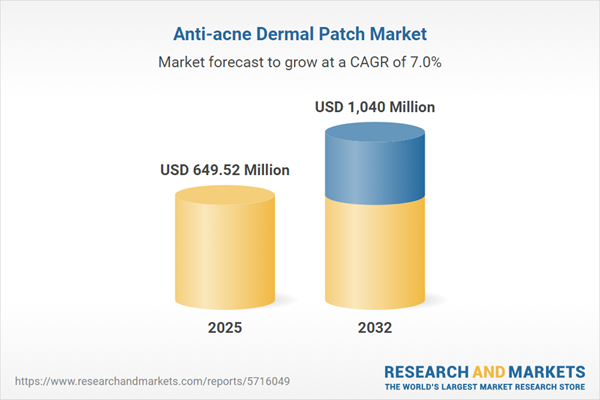Speak directly to the analyst to clarify any post sales queries you may have.
The anti-acne dermal patch market is evolving rapidly, shaped by technological advances, shifting supply networks, and diversified consumer preferences. Senior executives require targeted, timely intelligence to make informed decisions in this expanding field, where proactive strategies drive measurable results.
Market Snapshot: Anti-Acne Dermal Patch Market
In 2024, the Anti-acne Dermal Patch Market was valued at USD 606.32 million, growing to USD 649.52 million in 2025. Backed by a 7.03% compound annual growth rate (CAGR), the market is projected to reach USD 1.04 billion by 2032. This trend highlights significant momentum, fueled by growing consumer focus on non-invasive skincare and innovation in topical treatment formats. As market demand accelerates, new entrants and established leaders continue to invest in advanced patch technologies and expanded product varieties, making anti-acne dermal patches a space marked by dynamic competition and opportunity.
Scope & Segmentation
This report delivers executive-ready guidance by dissecting the anti-acne dermal patch market into its primary segments and revealing actionable points for leadership.
- Product Types: Charcoal patches, hydrocolloid options (in blister packs, rolls, or sachets), salicylic acid variants, and silicone patches, ensuring a broad selection for diverse acne care requirements.
- Distribution Channels: Access spans dermatology clinics, retail outlets, and online pharmacies, supporting practical channel strategies for market penetration and tailored outreach.
- Age Groups: Segmentation encompasses 13–19, 20–35, and over 35 categories, enabling precise messaging and product adjustments for demographic relevance.
- Price Ranges: Evaluation across low-cost, mid-range, and premium segments, equipping decision-makers to optimize product positioning for different budgets and value perceptions.
- Application Areas: Designed for cheeks, chin, forehead, and nose, each patch category supports innovation and effective skincare delivery for targeted problem areas.
- Regional Coverage: Focus covers the Americas, Europe, Middle East & Africa, and Asia-Pacific, highlighting regional nuances in user behavior, regulatory requirements, and distribution infrastructures.
- Key Companies Analyzed: Performance benchmarking to sector players such as 3M Company, Hero Cosmetics Limited, CosRX Inc., Star Dermatology, Inc., Peach Slices, LLC, Avarelle Beauty, LLC, and DermaSox, LLC provides insights into shifting leadership and market dynamics.
Key Takeaways for Senior Decision-Makers
- Investment in formulation innovation is expanding product efficacy, supporting entry into new consumer segments and building brand differentiation.
- Growth in digital channel use, combined with targeted social campaigns, is essential to reach younger audiences and validate clinically developed products.
- Adapting product formats for different climatic and skin types addresses unmet needs in high-potential regional markets and differentiates offerings.
- Smart patch technologies, such as sensor-enabled products, are gaining traction, allowing for enhanced personalization and real-time feedback on skincare regimens.
- Robust supplier relationships and diversified sourcing strategies help companies reduce operational and logistic risks, enabling faster response to material supply disruptions.
- Adoption of integrated omnichannel frameworks, blending retail, e-commerce, and clinical distribution, supports greater responsiveness and customer satisfaction across segments.
Tariff Impact: Navigating Supply Chain Complexity
Recent United States tariffs for 2025 have raised raw material costs and complicated logistics, affecting the anti-acne dermal patch sector’s traditional sourcing models. In response, industry leaders emphasize local sourcing and selective vertical integration to safeguard operations. Companies also diversify supplier networks and test regional manufacturing hubs to reduce risk and support stable supply lines. Exploring free trade zones and pursuing tariff exemptions form critical components of strategic planning to maintain profitability and continuity amid evolving trade conditions.
Research Methodology & Data Sources
This report is anchored in a structured approach, leveraging executive interviews with leading dermatology professionals, material scientists, and supply chain specialists. Additional surveys capture usage and preferences by age and application site. Secondary insights are drawn from patent filings and regulatory documents, while stakeholder workshops validate findings and refine actionable recommendations.
Why This Report Matters
- Provides a clear, objective foundation to assess the shifting size, innovation patterns, and competitive landscape in the anti-acne dermal patch sector.
- Equips senior teams to anticipate regulatory and supply chain changes by presenting actionable strategies for adaptation and sustained resilience.
- Identifies new growth areas and emerging product technologies, enhancing resource allocation and supporting targeted expansion initiatives.
Conclusion
Innovation, supply chain complexity, and granular consumer needs continue to define the anti-acne dermal patch market. Strategic agility and informed leadership are essential for capturing new opportunities and overcoming sector challenges.
Additional Product Information:
- Purchase of this report includes 1 year online access with quarterly updates.
- This report can be updated on request. Please contact our Customer Experience team using the Ask a Question widget on our website.
Table of Contents
3. Executive Summary
4. Market Overview
7. Cumulative Impact of Artificial Intelligence 2025
List of Figures
Samples

LOADING...
Companies Mentioned
The key companies profiled in this Anti-acne Dermal Patch market report include:- 3M Company
- Hero Cosmetics Limited
- CosRX Inc.
- Star Dermatology, Inc.
- Peach Slices, LLC
- Avarelle Beauty, LLC
- DermaSox, LLC
Table Information
| Report Attribute | Details |
|---|---|
| No. of Pages | 186 |
| Published | October 2025 |
| Forecast Period | 2025 - 2032 |
| Estimated Market Value ( USD | $ 649.52 Million |
| Forecasted Market Value ( USD | $ 1040 Million |
| Compound Annual Growth Rate | 7.0% |
| Regions Covered | Global |
| No. of Companies Mentioned | 8 |









